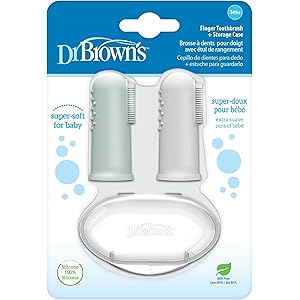Dr. Brown's Silicone Finger Toothbrush for Baby with Travel-Storage Case, 3m+, Gray and Light Green, 2 Count, (Pack of 1)
$5.99 (as of October 25, 2025 00:06 GMT +00:00 - More infoProduct prices and availability are accurate as of the date/time indicated and are subject to change. Any price and availability information displayed on [relevant Amazon Site(s), as applicable] at the time of purchase will apply to the purchase of this product.)What is Lochia?
Lochia refers to the vaginal discharge that occurs after childbirth, consisting of blood, mucus, and uterine tissue. This discharge is a natural part of the postpartum healing process, as the body expels the remnants of the placenta and other materials from the uterus. Understanding lochia is essential for new mothers as it provides insight into their recovery and overall health following delivery.
Types of Lochia
There are three distinct types of lochia that women may experience in the weeks following childbirth. Lochia rubra is the first stage, characterized by bright red blood and small clots, typically lasting for about three to four days. Following this, lochia serosa appears, which is pinkish-brown and consists of a mix of blood and mucus, lasting from about four to ten days. Finally, lochia alba emerges, which is yellowish-white and can last for several weeks, indicating that the body is nearing the end of the healing process.
Duration of Lochia
The duration of lochia can vary significantly from woman to woman, but it generally lasts between four to six weeks after delivery. Factors such as the type of delivery (vaginal or cesarean), the individual’s health, and whether they are breastfeeding can influence the length and characteristics of lochia. Monitoring the changes in lochia can help new mothers understand their recovery timeline and identify any potential complications.
What to Expect During Lochia
During the lochia phase, new mothers can expect changes in the color, consistency, and volume of the discharge. Initially, the discharge will be heavy and bright red, but it will gradually lighten in color and decrease in volume as the weeks progress. It is important for women to keep track of these changes, as any sudden increase in bleeding or the presence of foul odor may indicate an infection or other complications that require medical attention.
Lochia and Breastfeeding
Breastfeeding can have a significant impact on the duration and characteristics of lochia. When a mother breastfeeds, the hormone oxytocin is released, which helps the uterus contract and expel lochia more effectively. This can lead to a quicker recovery and a shorter duration of lochia for breastfeeding mothers. Additionally, breastfeeding can help reduce the risk of postpartum complications, making it an essential aspect of the recovery process.
Managing Lochia
Managing lochia involves maintaining proper hygiene and monitoring the discharge for any signs of complications. New mothers should use sanitary pads instead of tampons during this time to reduce the risk of infection. It is also advisable to change pads frequently to keep the area clean and dry. If there are any concerns about the amount or appearance of lochia, consulting a healthcare provider is recommended.
When to Seek Medical Attention
While lochia is a normal part of the postpartum experience, there are specific signs that warrant medical attention. If a mother experiences a sudden increase in bleeding, large clots, or a foul odor, it may indicate an infection or retained placental tissue. Additionally, if the discharge persists beyond six weeks or if there are any other concerning symptoms, it is crucial to seek advice from a healthcare professional.
Lochia vs. Menstrual Cycle
Many new mothers may wonder how lochia differs from their regular menstrual cycle. While lochia is a postpartum discharge that occurs after childbirth, the menstrual cycle typically resumes several weeks to months later, depending on factors such as breastfeeding. Lochia is characterized by its gradual change in color and consistency, while menstruation usually presents as a more consistent flow of blood. Understanding these differences can help women navigate their postpartum recovery more effectively.
Emotional Impact of Lochia
The experience of lochia can also have an emotional impact on new mothers. The physical changes and the reminder of childbirth can evoke a range of feelings, from joy to anxiety. It is essential for women to acknowledge these emotions and seek support from partners, family, or healthcare providers if needed. Open conversations about postpartum experiences, including lochia, can foster a supportive environment for new mothers as they navigate this transformative time.
Conclusion
While this section does not include a conclusion, it is important to remember that lochia is a natural part of the postpartum journey. By understanding what lochia is, its types, duration, and how to manage it, new mothers can feel more empowered during their recovery process. Seeking support and staying informed about their bodies can help women navigate the challenges of motherhood with confidence.



